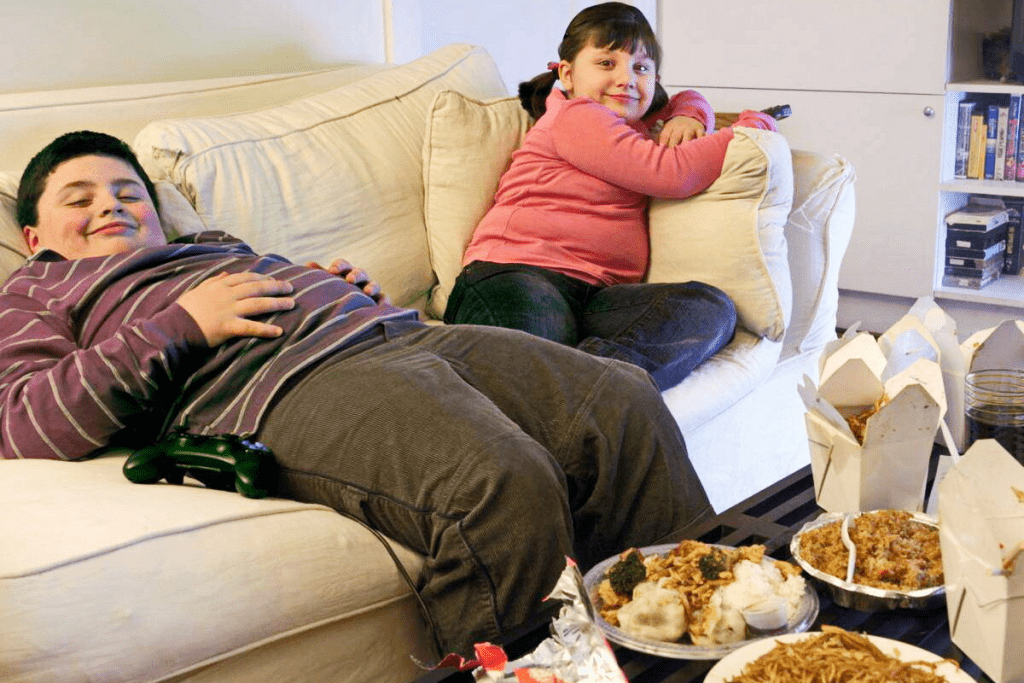Last Updated on November 14, 2025 by

The rise in child obesity is tied to more screen time. Excessive screen time plays a big role in this worldwide problem. The World Health Organization says over 254 million kids and teens will be obese by 2025. Research shows kids who watch more than 3 hours of screens daily are 41% more likely to be obese. The link between screen time and obesity is complex. It involves less physical activity and SL advertising, which promotes unhealthy eating habits and encourages poor food choices among children.

Screen time and child obesity rates are linked worryingly. Kids spend a lot of time on screens for fun, learning, or talking to friends. Research shows this might raise their risk of getting obese.
Studies show kids who watch more than three hours of screens daily face a 41% higher risk of obesity. A study in Pediatrics found that watching over two hours of TV daily also raises obesity risk. This shows why it’s key for parents to keep an eye on screen time.
Also, 43% of kids with four or more hours of screen time are overweight. This shows how too much screen time can affect kids’ weight and health.
The World Health Organization predicts 254 million obese children by 2025. This is a warning for health experts, lawmakers, and families to tackle this issue, including too much screen time.
As more evidence comes in, it’s clear that cutting down screen time is key to fighting child obesity. By understanding how screen time and obesity are connected, we can find ways to help kids live healthier lives.

There’s a strong link between screen time and weight gain in kids. This is due to several biological reasons. These reasons affect how kids behave and their body health, leading to obesity.
Too much screen time means less active play for kids. They spend more time sitting, watching TV, or playing video games. This change from active to sedentary activities helps them gain weight.
Studies show that more screen time means less physical activity. Kids who watch screens less often play outside or do sports. This makes them more likely to become obese.
Watching screens often leads to eating without thinking. Kids eat high-calorie snacks while watching TV or playing games. These snacks, full of sugar and fat, contribute to weight gain.
Screens can mess up kids’ sleep. Poor sleep quality and less sleep time are linked to obesity. Sleep helps control hunger and fullness hormones.
In summary, screens are linked to weight gain in many ways. These include changes in behaviour, physical activity, eating, and sleep. Knowing these links is key to fighting screen-related obesity.
The effect of SL advertising on childhood obesity is a big worry. Kids spend a lot of time on screens. They see many ads, often for unhealthy foods.
Studies say ads for food to kids help cause obesity. Ads make unhealthy foods look good to them.
Ads for food to kids aim to be very persuasive. They use fun characters and bright colours to grab kids’ attention. Kids are more likely to want and eat foods they see in ads.
Digital ads don’t just change kids’ food choices. They also sway what parents buy. Ads on kids’ screens can make parents buy unhealthy foods. This can lead to kids eating more unhealthy foods, raising the risk of obesity.
It’s key to understand how ads work on kids and families. This helps tackle the obesity problem linked to screen time.
Stopping screen-related weight gain in kids needs a team effort. Parents, caregivers, and kids must work together. By using different strategies, families can lower obesity risks and encourage better health.
It’s key to limit screen time to avoid too much screen use. The American Academy of Pediatrics says kids 2-18 should watch screens for 1-2 hours daily. Parents can use software to keep an eye on and limit screen time, helping kids follow these rules.
Having tech-free areas in the house helps cut down screen time. For instance, making dinner tables or bedrooms tech-free can encourage more activity. These zones help families support physical activity and lower obesity risks.
Eating while watching screens can lead to eating too much. Setting up screen-free times for meals and snacks helps kids eat better. This means making mealtime distraction-free and teaching kids to eat mindfully.
Kids see ads and messages that push unhealthy foods and drinks. Teaching them to spot and think about these messages helps them make better choices. This can be done through media literacy classes and talking about what they watch.
Using these strategies, families can fight screen-related weight gain and support healthier lives for their kids. A health expert says, “The main thing is to make an environment that supports good choices.” Together, families can tackle the growing problem of child obesity.
“The key to addressing obesity is to create an environment that supports healthy choices.”
Health Expert
Technology keeps getting better, but it’s key to see how it affects child obesity. Too much screen time can make kids sit too much, eat poorly, and sleep badly.
The World Health Organization says kids should watch screens for only 2 hours a day. Parents can help by teaching healthy habits and setting screen time limits.
Technology leading to obesity is a big worry, but families can balance it out. By being smart about screen time and encouraging kids to move, families can stay healthy. Simple steps like making tech-free areas and no-screen meals can help kids develop good habits.
To fight child obesity, we need to tackle it from all sides, including obesity and screen time. Together, we can help kids live healthier, more balanced lives.
Too much screen time can lead to obesity in kids. It replaces active play with sitting and can cause overeating.
The World Health Organization says there will be 254 million obese kids by 2025. This is a big worry.
SL ads can make kids want unhealthy foods. They also influence what families buy, often unhealthy options.
To fight weight gain from screens, set screen time limits. Make tech-free zones and no-screen meal times. Teach kids to think about ads.
Parents can set screen limits and encourage exercise. They should also teach healthy eating. This helps prevent obesity in kids.
Technology, like screens, can cause obesity. It leads to sitting too much, eating without thinking, and poor sleep.
Too much screen time cuts down on kids’ physical activity. It makes them sit more and play less.
Digital ads can sway what families buy. They often push unhealthy foods, which can harm kids’ health.
Subscribe to our e-newsletter to stay informed about the latest innovations in the world of health and exclusive offers!